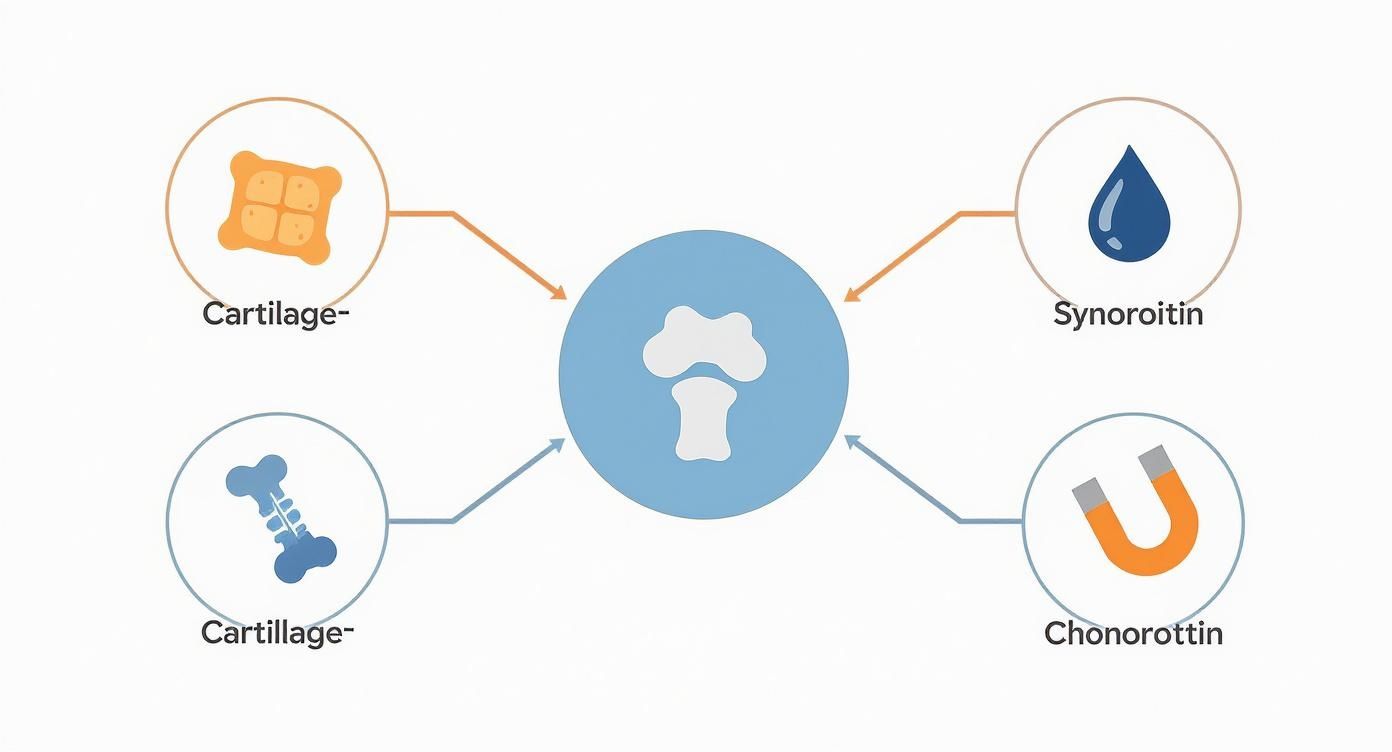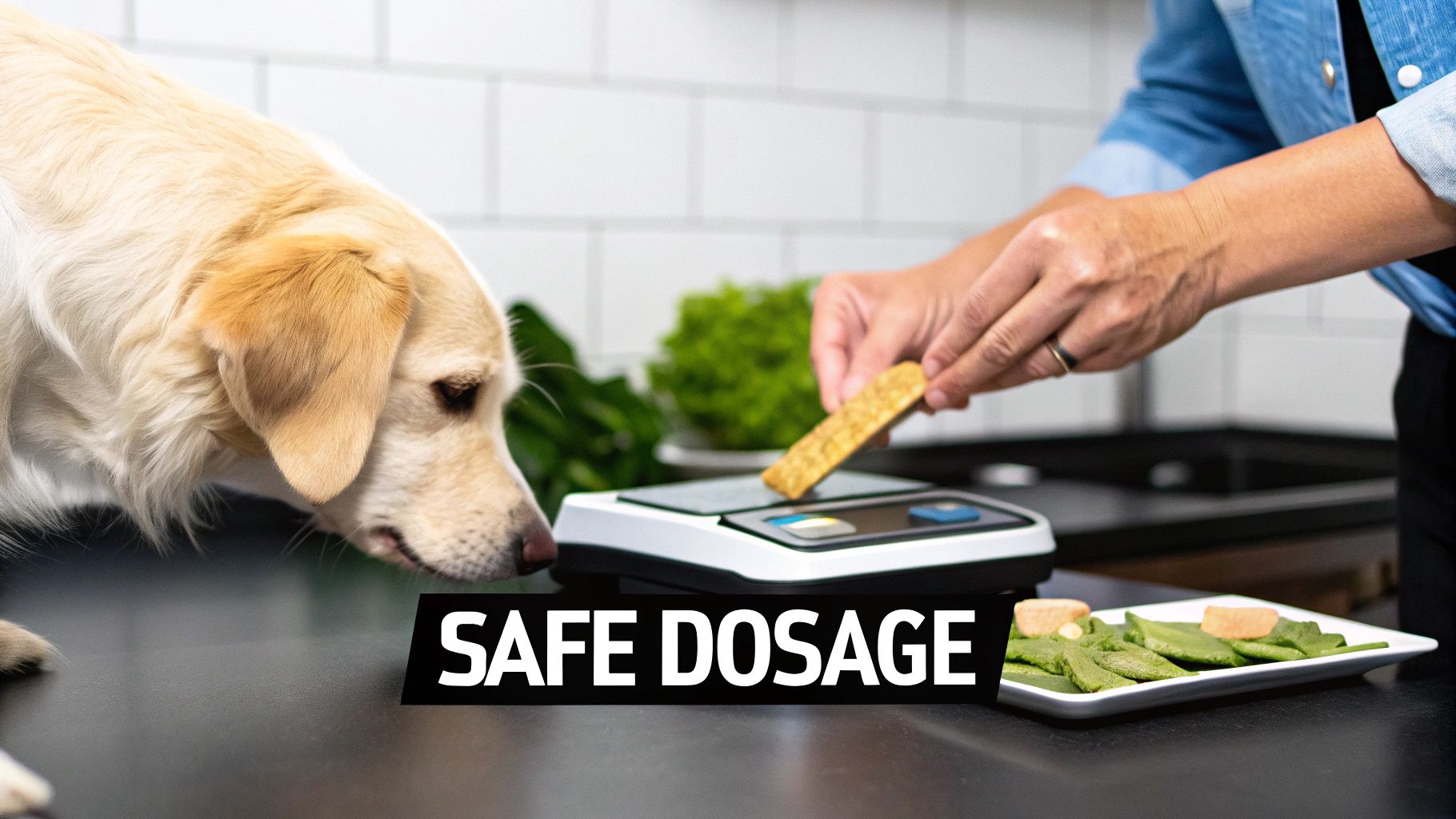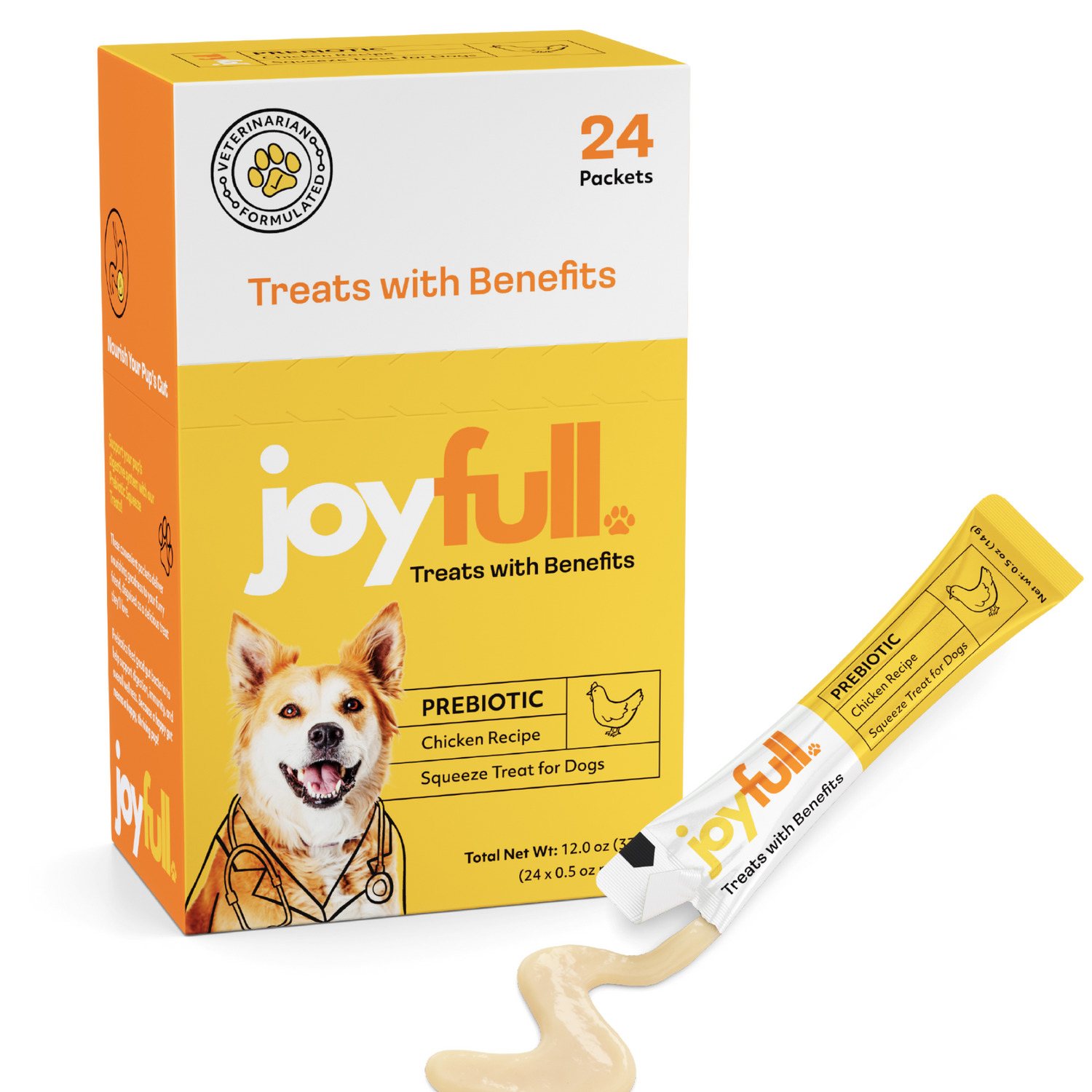
Is Glucosamine Good for Dogs A Pet Owner's Guide
If you've noticed your dog slowing down, getting a little stiff, or just not bouncing around like they used to, you might be wondering about joint supplements. For many dogs, especially those showing early signs of arthritis or breeds prone to joint trouble, the answer is a big yes—glucosamine can be a game-changer.
Think of it as the secret ingredient for joint maintenance. It helps cushion your dog's movements and can slow down the natural wear and tear on their cartilage over time. It's one of the most common proactive steps veterinarians recommend for supporting mobility and keeping that spring in their step.
Understanding the Role of Glucosamine in Your Dog's Health

So, what is glucosamine, really? It’s a naturally occurring amino sugar that acts as one of the core building blocks for healthy cartilage. This cartilage is the smooth, rubbery tissue that cushions the ends of bones within a joint, acting like a natural shock absorber.
As dogs get older, their bodies produce less glucosamine. When this happens, the cartilage can start to thin and wear down, making movement painful and potentially leading to osteoarthritis. By adding a glucosamine supplement to their daily routine, you're essentially topping up their supply of these crucial joint-repair materials.
It's not an overnight fix for an injury, but rather a long-term strategy to support the very structure and function of their joints. Glucosamine works quietly in the background, helping to maintain the thick, slick synovial fluid that lubricates the joints and ensures they glide smoothly without friction.
Key Benefits of Glucosamine
By supporting cartilage and joint fluid, glucosamine offers a few key advantages that you might notice in your own dog:
- Improved Mobility: It often helps ease stiffness, making it noticeably easier for your dog to get up, walk, run, and tackle the stairs.
- Reduced Discomfort: Many pet owners report that their dogs just seem happier, more comfortable, and more energetic after starting a glucosamine regimen.
- Slows Cartilage Deterioration: By providing the raw materials needed for repair, it can help slow the progression of degenerative joint conditions.
Setting Realistic Expectations
It's really important to have a clear picture of what glucosamine can and cannot do. It's not going to reverse severe, existing joint damage. Instead, think of it as a powerful tool for managing symptoms and improving your dog's overall quality of life. It’s one piece of a holistic wellness plan.
Glucosamine is a supportive therapy, not a cure. Its primary role is to maintain existing joint health and slow down further degradation, which is why it's often recommended for both senior dogs and breeds prone to joint problems.
To get a quick overview, this table breaks down the essential information about glucosamine for your dog.
Glucosamine for Your Dog Key Takeaways
| Aspect | What You Need to Know | Impact on Your Dog |
|---|---|---|
| Primary Function | A natural compound that builds and repairs cartilage. | Helps cushion joints and maintain smooth movement. |
| Key Benefit | Slows cartilage breakdown and reduces joint inflammation. | Eases stiffness, improves mobility, and reduces discomfort. |
| Best For | Senior dogs, breeds prone to joint issues, and dogs with early arthritis. | Proactively supports long-term joint health and comfort. |
| Timeline | It's a long-term supplement, not a quick fix. Results may take 4-8 weeks. | Requires consistent daily use to see and maintain benefits. |
| Safety | Generally very safe with few side effects. | Always check with your vet for the right dosage and product. |
Ultimately, using a glucosamine supplement is about helping your dog feel their best for as long as possible.
Caring for our pets is a two-way street; we support their physical comfort, and in return, they enrich our lives immensely. Beyond just supplements, it's always worth remembering the surprising ways owning a pet can improve your health and well-being.
How Glucosamine Actually Works in Your Dog's Joints
To really get why so many vets recommend glucosamine, it helps to take a little peek inside your dog's joints to see what’s going on at a microscopic level. It's actually a pretty simple concept. Picture your dog’s joint cartilage like the thick, bouncy sole on a brand-new pair of running shoes—it’s firm, flexible, and built to absorb shock.
Every time your dog runs, jumps, and plays, that natural cushion takes a hit. Over the years, this constant wear and tear starts to thin it out, and the body's natural repair process just can't keep up as they get older.
This is where glucosamine comes into play. It's a natural compound that serves as a fundamental building block for both creating new cartilage and patching up the old stuff. By adding it to your dog's diet, you're essentially giving their internal "repair crew" the raw materials they need to get to work and maintain that all-important joint cushion.
The Role of Synovial Fluid
But glucosamine’s job doesn’t stop with cartilage. It also plays a huge part in producing synovial fluid. The best way to think of this fluid is like the oil in a car's engine. It's a thick, viscous liquid that lubricates the entire joint, allowing the bones to glide past each other without any friction.
When a dog has healthy levels of synovial fluid, movement is smooth and easy. But as joints degrade, this fluid can thin out, which is what leads to that familiar stiffness and discomfort. Glucosamine helps keep this essential lubricant viscous and effective, making sure the whole joint mechanism runs like a well-oiled machine.
The Power Duo: Glucosamine and Chondroitin
You’ll almost never find glucosamine sold by itself; it's nearly always paired with another compound called chondroitin sulfate. There’s a very good reason for that. If glucosamine is the "brick" used to build cartilage, then chondroitin is the "sponge" that keeps it healthy.
Chondroitin's main job is to help cartilage attract and hold onto water. This is critical for keeping it spongy and shock-absorbent. A well-hydrated cartilage cushion is far more resilient and does a much better job of protecting the joint from the daily grind.
Here’s a simple breakdown of how they work as a team:
- Glucosamine: Provides the structural pieces needed to build and repair the cartilage matrix.
- Chondroitin: Draws moisture into that matrix, giving it elasticity and the ability to resist compression.
Together, glucosamine and chondroitin are a true power couple for joint health. One builds the framework, and the other makes sure it stays hydrated and functional. This one-two punch offers a far more complete approach to joint support than either could on its own.
This internal support system is what you see on the outside—a dog that gets up from their bed a little easier, seems happier on walks, and just enjoys a better quality of life. It’s not a painkiller masking the problem; it's a foundational supplement that works to improve the actual health of the joint itself.
What the Science Says About Glucosamine for Dogs
When you’re trying to decide if glucosamine is right for your dog, it’s only natural to ask: does the research actually back this up? The answer is a hopeful one, but it’s not exactly black and white. While many studies point to real benefits, the results can vary, painting a picture that’s mixed but generally optimistic.
https://www.youtube.com/embed/ERfMAqLLd_4
Think of the scientific evidence like a collection of stories. Some are glowing success tales, others show small but steady improvements, and a few report little change at all. This difference often boils down to things like the quality of the supplement, the specific dosage given, and the exact joint condition being treated. The trick is to look at the overall pattern rather than getting hung up on a single result.
A major review of 16 different canine studies gives us a great overview. It found that 100% of the non-randomized trials and 57% of the more rigorous randomized controlled trials (RCTs) showed positive effects from glucosamine and chondroitin. But it's also worth noting that many of these studies were on the smaller side and often relied on owner observations instead of objective measurements. This context helps explain some of the inconsistencies you might see across the data. You can dig deeper by exploring the details of this scientific review.
Translating Clinical Data Into Real-World Benefits
So, what does all this scientific back-and-forth mean for your dog curled up on the rug? It means that while glucosamine isn’t a magic bullet, there's a solid body of evidence suggesting it can genuinely improve comfort and mobility for many dogs, especially those dealing with osteoarthritis.
When vets and owners see it work, these are the benefits they most often report:
- Reduced Pain Scores: You might notice a clear drop in pain signals, like less whimpering or flinching when touched.
- Improved Weight-Bearing: Dogs often become more willing to put their full weight on a limb that used to be sore.
- Increased Activity Levels: Many dogs get their spark back and show more excitement for walks, playtime, and just moving around.
This infographic breaks down exactly how glucosamine gets to work supporting the joint's structure, helping to maintain cartilage and the all-important synovial fluid.

It’s a simple visual that shows how these key components team up to cushion and lubricate the joint, allowing for much smoother and more comfortable movement.
Why Study Results Differ
It’s fair to wonder why one study might report fantastic results while another is less enthusiastic. A few key factors can really sway the outcome of research on supplements like glucosamine.
A huge one is the quality and composition of the supplement itself. Let's be clear: not all glucosamine products are created equal. The source of the glucosamine, its purity, and whether other helpful ingredients are included can all make a big difference in how well it works.
The scientific consensus leans toward glucosamine being a beneficial, low-risk supportive therapy for canine joint health. While not every study is conclusive, the weight of evidence points toward real quality-of-life improvements for dogs with joint discomfort.
On top of that, combining glucosamine with other ingredients known for their anti-inflammatory effects can create a more powerful, synergistic result. For instance, many pet owners look to natural additions for their dog's diet. If you’re curious about other supportive ingredients, you can find out if dogs can eat turmeric for its anti-inflammatory properties in our guide.
The takeaway here is that the science, while complex, generally gives a thumbs-up to using glucosamine as a safe way to help your dog stay active and comfortable for years to come.
When to Consider Glucosamine for Your Dog
Knowing when to start a supplement is a huge part of being a proactive pet parent. So, when is the right time to introduce glucosamine? It's often not when your dog is already showing obvious signs of pain. In many cases, the best time to start is long before serious joint issues ever develop.
Think of glucosamine as the dedicated “maintenance crew” for your dog’s joints. It works quietly in the background, helping to repair and strengthen cartilage over the long haul. This is a completely different job than what pain medications like NSAIDs do. NSAIDs are more like “firefighters”—they show up to quickly douse the flames of acute pain and inflammation. Glucosamine’s role is supportive and preventative, not a quick fix for immediate pain.
Common Scenarios for Starting Glucosamine
Certain breeds, life stages, and subtle behaviors are clear signals that your dog could benefit from a joint supplement. Keep an eye out for these tell-tale signs, as they often mean the normal wear and tear on their joints is starting to add up.
You should think about starting a glucosamine supplement if you notice:
- Subtle Changes in Activity: Maybe your dog hesitates for a split second before jumping on the couch, or they seem a little stiff getting up from a nap. Even lagging behind on walks they used to eagerly lead can be an early clue.
- Breed Predisposition: Some breeds are just hard-wired for joint problems like hip dysplasia. We're talking about German Shepherds, Labradors, Golden Retrievers, and Great Danes, among others. For these dogs, starting glucosamine early is a powerful preventative move.
- Senior Status: Once a dog hits their golden years (around age seven for most larger breeds), their body's natural glucosamine production starts to slow down. Supplementing helps fill that gap, supporting their joints as they age.
Glucosamine isn't just a reaction to a problem; it’s one of the best proactive tools you have for managing your dog's long-term joint health. Starting early, especially for at-risk breeds, can make a world of difference in their comfort and mobility later in life.
This supportive approach isn't just talk; it's backed by solid research. One landmark clinical trial discovered that after 70 days, a glucosamine and chondroitin blend was just as effective as the common NSAID carprofen for reducing pain and improving weight-bearing in dogs with osteoarthritis. You can read more about these important clinical findings. This shows it can be a fantastic long-term management option, especially for dogs who may not tolerate traditional pain meds well.
This kind of long-term care is a key piece of the puzzle. The right supplements work hand-in-hand with other wellness strategies, like providing joint-friendly treats. For a more complete picture, take a look at our guide on choosing the best dog treats for arthritis. Ultimately, catching those early signs and taking action is how you help your best friend enjoy a more comfortable, active life for years to come.
Choosing a Safe and Effective Glucosamine Supplement

Stepping into the supplement aisle can feel like a lot to take in, but finding a high-quality glucosamine product for your dog is simpler than you might think. The most important thing to look for right off the bat is a seal of quality from a trusted, independent group.
Your best bet? Look for the National Animal Supplement Council (NASC) Quality Seal. This little seal is a big deal. It means the company has voluntarily undergone a tough, third-party audit, proving that what's on the label is exactly what's in the product. It’s your assurance of quality control and accuracy.
How to Read the Label
Once you've spotted a product with a quality seal, it's time to become a label detective. This is where you find out if the supplement is a good match for your specific dog.
Here's what to zero in on:
- Glucosamine Source and Form: The label should tell you where the glucosamine comes from, which is usually shellfish. It will also specify the form—most commonly glucosamine hydrochloride (HCl) or glucosamine sulfate. Both work well, but HCl is a bit more concentrated.
- Active Ingredients Per Serving: This is crucial. Check how much glucosamine, chondroitin, or other active ingredients are in each chew or tablet. You need this number to make sure you’re giving the right dose for your dog’s weight.
- Inactive Ingredients: Take a quick scan of this list. You want to see beneficial ingredients, not a long list of artificial fillers or additives that do nothing for your dog's health. You can dive deeper into finding the best natural dog joint supplements in our guide.
Crucial Safety Warning: It’s tempting, but never give your dog glucosamine supplements made for humans. Formulas for people often contain ingredients that are incredibly toxic to dogs, like the artificial sweetener xylitol. Even a tiny amount can be fatal.
Always, always stick to products made just for dogs. They’re formulated with the right dosage levels and safe inactive ingredients designed for a canine’s system. Taking these few extra steps will give you the confidence that you’re choosing a supplement that's both safe and genuinely helpful for your best friend.
Finding the Right Dose and Monitoring for Side Effects

Giving your dog a new supplement correctly is every bit as important as picking a high-quality product in the first place. While you'll see general dosage guidelines on product labels and online, think of them as a starting point for a crucial conversation with your veterinarian. This step is absolutely non-negotiable.
Your vet is the only one who sees the full picture of your dog's health—their age, weight, the specific joint issues they're facing, and any other medications they might be taking. Based on all that, they can give you a personalized recommendation for a safe and effective dose.
Often, your vet will suggest a "loading dose." This just means giving a higher amount for the first few weeks to help build up the glucosamine levels in your dog's system more quickly, before dropping back to a lower, long-term "maintenance dose."
General Dosage Guidelines
Again, your vet’s advice is gospel, but it helps to have a ballpark idea of what to expect. Dosing is almost always based on your dog's weight.
- Small Dogs (5-20 lbs): 250–500 mg per day
- Medium Dogs (20-45 lbs): 500 mg per day
- Large Dogs (45-90 lbs): 1,000 mg per day
- Giant Dogs (Over 90 lbs): 1,500 mg per day
These ranges help ensure your dog gets enough of the good stuff to support their joints without going overboard.
Watching for Potential Side Effects
Here’s the good news: most dogs handle glucosamine extremely well. Side effects are pretty uncommon and almost always mild when they do pop up. Still, it pays to be vigilant and know what to look for.
The most common complaint is some minor digestive upset, like gas or loose stools. The best way to head this off is to introduce the supplement slowly. Start with just a fraction of the recommended dose and gradually work your way up over a week or two. This lets your dog's system get used to it without any sudden shocks.
Keep an eye out for any changes after starting glucosamine. Watch for symptoms like vomiting, diarrhea, or unusual fatigue. While rare, if you notice any of these signs, stop the supplement and contact your vet.
Taking it slow and paying close attention is the best strategy. It ensures that adding glucosamine to your dog's routine is a positive experience from day one.
Common Questions About Glucosamine for Dogs
Even with a good grasp of the benefits, you probably still have a few questions rolling around in your mind. That's completely normal. Let's dig into some of the most common things dog owners ask so you can feel confident about what's best for your furry friend.
Can I Give My Dog Human Glucosamine Supplements?
This is a big one, and the answer is a hard no. It might seem like the active ingredient is the same, but human supplements pose a serious threat to dogs for a couple of major reasons.
First off, many products made for people contain xylitol, an artificial sweetener. While it's safe for us, it's incredibly toxic to dogs and can quickly lead to life-threatening low blood sugar and even liver failure. Secondly, the dosages are calculated for a full-grown human, making it almost impossible to get the amount right for your dog. It's just not worth the risk—always use a formula made specifically for canines.
How Long Until I See Results in My Dog?
This is where a little patience goes a long way. Glucosamine isn't a quick fix or a painkiller; it works from the inside out, giving your dog’s body the raw materials to support and maintain healthy joint cartilage.
Most owners start to see a real difference in their dog's comfort and mobility within four to eight weeks of giving it to them every single day. Think of it as a long-term investment in their joint health. Stick with it, because consistency is what truly unlocks the benefits.
Is Glucosamine Safe to Give to My Puppy?
Generally speaking, a healthy, bouncy puppy doesn't need glucosamine. Their little bodies are already in overdrive, producing everything they need to build strong, resilient joints. In fact, adding extra supplements could potentially throw a wrench in that delicate and complex development process.
The only real exception is if a veterinarian specifically diagnoses a developmental joint issue and recommends it as part of a treatment plan. Otherwise, hold off until your dog is an adult or heading into their golden years.
While this guide is all about your dog's physical health, we know the bond you share goes much deeper. Being a great pet owner means navigating the entire journey, including the tough parts. Having resources on hand for things like coping with pet loss is just another part of being prepared for a lifetime of love.
At Joyfull, we believe your pets deserve the best. Our formulas are made with clean, high-quality ingredients reviewed by our veterinary advisor to support a healthful, happy life. Explore our products today at https://joyfullpet.com.

